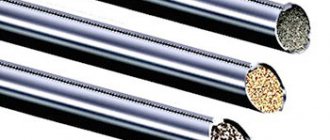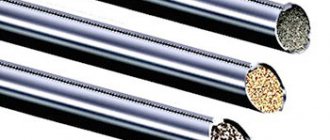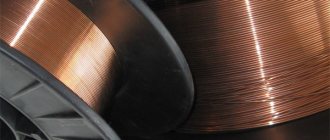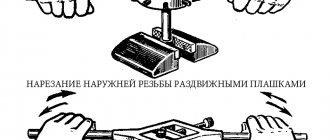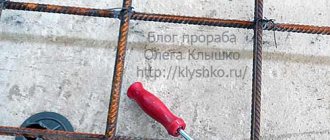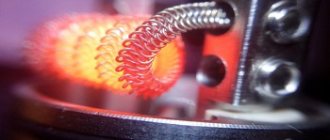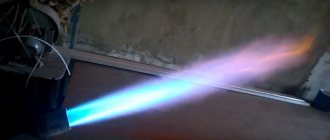Welding or filler wire is supplied in reels. This is convenient for industrial lines: the reel is installed on the feeder and the rod is automatically sent to the welding zone. An alternative is manual material feeding, which is common outside of mass production.
The filler rod itself can be different: solid, hollow or with special inclusions. The metals from which it is made also have a wide range: aluminum, brass and others. When choosing this parameter, welders pay attention first of all: the composition of the additive must be identical to the metals being welded.
Types of welding wire
When carrying out welding work, the following types of wire are used:
- powder _ In demand when working with carbon steel, which will subsequently be subject to heat treatment;
- aluminum _ It is used when welding workpieces made of the same material. The content of silicon, manganese, magnesium and other inclusions is allowed);
- stainless steel Suitable for working with stainless metals: steel containing chromium or nickel;
- copper-plated - for working with high and medium alloy steel;
- steel _ Designed for welding medium and low alloy steel.
By purpose
Welding wire is classified according to a number of parameters, the main ones being structural features, chemical composition, and specific use.
According to purpose, it is divided into products of general and special use. The first is used when welding all grades of steel (the letters Sv are present in the marking), as well as in surfacing (Np). The second is used when welding special alloys, cast iron, when performing welding work under water, as well as when welding with forced formation of a seam.
In the second case, the chemical composition of the filler material is, as a rule, completely identical to the composition of the base metal.
Wire for stainless steel
This filler material is used in cases where steel containing chromium or nickel is welded in an inert environment. Main advantages:
- the result is a high quality seam;
- there are no cracks on the surface of the welded joint;
- the seam is resistant to corrosion;
- a small amount of splashes;
- arc stability.
Stainless steel welding wire has an important advantage: it creates a weld with an increased service life. It is made from high-alloy steel, in which the content of nickel, chromium and other similar inclusions is high. They minimize the likelihood of rust formation or the onset of corrosion processes.
Wire can be solid or cored. The first is used for working in an inert environment or submerged arc. Shielding gases are necessary to prevent the penetration of atmospheric oxygen, which could oxidize the stainless steel during the thermal joining process. Of course, this will negatively affect the quality of the weld.
Powder consumables are a thin-walled tube into which flux and additional elements for gas formation are poured. Their advantage is that an inert environment is not required. I form the protective shell with such filler materials myself. They are usually called self-protective.
During operation, the consumable passes through the current-carrying tip. Because of this, its diameter may decrease slightly, which ultimately reduces the quality of the welded joint. Therefore, wire is usually divided into normal and high-precision. The diameter varies over a wide range of values: from 0.13 to 6 millimeters. The key parameter influencing the choice of filler wire for welding stainless steel workpieces is the matching of the material of the parts and consumables.
Device, principle of operation
The welding station includes:
- Source of arc formation (transformer, rectifier, inverter). In addition to the voltage converter, it includes a control unit and a mechanism for automatically feeding a flexible electrode. The latter can be made in the form of a separate autonomous device - these units belong to the professional series.
- Shielding gas and wire supply hose. It ends with a conductive burner mouthpiece.
- Power cable connected to the workbench or directly to the workpiece (ground clamp).
- Gas system: gas cylinder, pressure reducer, hose.
The equipment is portable (household series) or transportable (semi- and professional series), equipped with two (four) wheels. Power is supplied from a stationary power supply 220V or 380V.
220V units are less powerful than 380V units, but are successfully used to solve household problems or are used in small mechanic shops (for example, car repair shops).
Operating principle:
- The preparation procedure (including the gas system) and switching on are described in detail in the instructions for each model.
- The arc is ignited through a tungsten tip. After the flame is formed, the necessary adjustment of the current parameters occurs. The gas component is started and the wire feed is turned on.
- The flexible rod acts as a consumable electrode, that is, it is a filler wire. The task is to create a weld in the form of a weld bead of metal.
Copper-clad wire
The material has the same set of advantages as wire for welding stainless steel. Plus, it also helps reduce tip consumption, regardless of the brand of welding machine. The main purpose is to join high-alloy and carbon steels in a protected environment.
The consumable is supplied to the consumer market wound on a plastic cassette. Thanks to ease of use, the productivity of specialists increases. The standard thickness of copper-plated wire is 0.6; 0.8 and 1 mm. It simplifies the re-ignition of the welding arc and maintains the stability of its combustion in different modes.
A classic example of such a consumable material is SV-08G2S wire, which contains 1% silicon, 2% manganese and 0.8% carbon. Another option is esab brand welding wire, designed to work with a wide range of steels, including tool, marine, stamped; stainless steel, aluminum and even cast iron.
Principle of operation
The operation of the unit is based on the principle of creating an electric arc. Heat generation is directed:
- for heating metal blanks;
- melting of metal at the junction of parts;
- melting of the metal base of the electrode.
Electric current is applied through the wire, forming a welding arc between the workpiece and the electrode. The electric arc has increased resistance relative to the metal of the wire. Hence, most of the heat flux is generated in the arc plasma.
The use of a flexible thin electrode allows:
- reduce the effect of splashing liquid metal;
- increase the size of the weld pool (penetration depth);
- make connections of thin-sheet materials (for example, cold-rolled steel sheet);
- weld stainless steels, non-ferrous metals (aluminum, copper).
Steel wire
It is used in most areas of human production activity. It is characterized by a large number of indicators, the main of which are the cross-sectional diameter, strength and composition of the material used in manufacturing. There are many types of steel wire: reinforced, spring welding, barbed and others. The marking of the material intended for welding contains the abbreviation “St”. Available in different diameters: from 0.3 mm to 12 mm.
There are more than fifty different brands of products, which can be divided into three groups:
- For steel with low carbon content. As an example: Sv-10G2, Sv-08, Sv-YUGL.
- For welding low and medium alloyed workpieces. Wire brands Sv-08G2S, Sv-18HS, Sv-08GS and others are suitable.
- For connecting structures made of high-alloy steel: Sv-12Х13, Sv-08Х14GNT.
In some cases, the surface of the steel wire is coated with a thin layer of copper. This is done to protect the metal from oxidation and improve its electrical conductivity.
Steel wire is used when working with inert gases or submerged arcs. This is the consumable material most suitable for argon welding. Chromium, manganese, nickel, titanium, tungsten or molybdenum are used as alloying elements in manufacturing. Thanks to the first three components, it is possible to join stainless steel with a high carbon content.
What models to pay attention to
Models are presented in two types:
- rectifier;
- inverter
Rectifier
It consists of a power transformer and a block of diodes that generate a unidirectional pulsating current. Equipped with a wire feed mechanism. They work in several modes:
- MIG/MAG - solid wire is used.
- Activated wire is used - a composite material made from a layer of protective flux, base metal and alloying additives.
- A powder electrode is a hollow tubular structure with flux inside.
- Spot resistance welding (for professional models).
Most of the models produced belong to the semi- and professional class. Wire welders used in everyday life or small workshops have:
- power up to 10 kW;
- maximum welding current up to 250 A;
- open circuit voltage 15-45 V;
- weighing 25-35 kg.
Model SPECIAL MAG-172. Semi-automatic, used for welding in the “with/without gas” mode. Connects ferrous and stainless steel, non-ferrous metals (aluminium, copper) and alloys based on them.
Model ENKOR-140 MIG 56731. Device for working with low-carbon or stainless steel. Used with inert or active gas. It is possible to use a powder flexible electrode.
| Characteristics | SPEC MAG-172 | ENKOR-140 MIG 56731 |
| Power | up to 6.3 kWt | up to 5.5 kWt |
| Current | up to 250 A | up to 140 A |
| PV at maximum mode | no more than 10% | no more than 10% |
| Assembled weight | up to 35.5 kg | up to 28 kg |
Inverter
The source of arc creation is an inverter. Consists of primary and secondary rectifiers, high-frequency transformer, control unit. Settings are automated. They are small in size and have the following functions:
- Manual arc welding with all electrodes.
- Connecting parts using inert or active gas with automatic supply of a flexible electrode.
- Use of powder electrode or activated wire.
- Non-consumable electrode operation with or without gas.
Models of all classes are produced: household, semi- and professional. Convenient for beginner welders. This is explained:
- ease of use;
- stable electric arc characteristics;
- resistance to changes in voltage parameters in a stationary power supply network.
Model Resanta SAIPA 135. Semi-automatic device used for joining workpieces made of ferrous and stainless steels, non-ferrous metals. It is used for welding with and without gas, as well as with flux-cored wire.
Model Svarog REAL MIG 200. Semi-automatic for working in MMA, MIG/MAG modes and powder electrodes. Connects low-carbon and stainless steel, aluminum alloys. Mains voltage 220 V.
| Characteristics | SAIPA 135 | SVAROG REAL MIG 200 |
| Power | up to 6.6 kWt | up to 5.4 kWt |
| Current | up to 110 A | up to 200A |
| PV at maximum mode | no more than 70% | no more than 60% |
| Assembled weight | 11 kg | 13 kg |
Aluminum wire
Used when working with aluminum alloys in which the silicon content does not exceed 3%, and copper - from 3 to 5%. Products manufactured for semi-automatic welding machines are made of aluminum, which has a positive effect on seam formation:
- gives additional strength;
- exactly matches the color of the blanks;
- has the same corrosion resistance as any other aluminum alloy.
Most often used in automotive production and shipbuilding. In third place in demand are organizations where welded structures interact with water. Characterized by excellent ductility and low weight; Most often used in gas welding. Suitable for joining other non-ferrous metals.
In practice, there are no metal parts or structures that consist of pure aluminum. Additional inclusions are always used to improve certain characteristics. This statement is also true for the welding wire itself, although often the amount of additives is measured to not exceed one percent. For example, only 0.2% titanium allows a specialist to make a fine-grained seam, which is extremely necessary when performing precision work.
However, according to GOST, pure aluminum wire is defined as a separate category. In addition to it, there are alloys with magnesium, copper or silicon. In addition to the provisions of the state standard, there are technical conditions that regulate the production of other alloys: with chromium, as well as with silicon and magnesium.
An important condition for a high-quality connection is the correspondence of the composition of the workpieces and the consumable material. Only magnesium, which actively evaporates at high temperatures, can be considered as an exception. Its composition in the additive can be 10-20% greater than the nominal value.
What else is needed for semi-automatic welding
When preparing for semi-automatic welding, you should carefully select additional equipment and especially the torch. Even if you are completely satisfied with it today, problems are still possible in the future. It's no secret that the working surface of the torch wears out over time, for example, from high temperature, accidental drops or welding spatter. Such information will be necessary and useful in any case.
Technical parameters of the burner:
- Indicator of maximum current strength. It ranges from 180 to 650 A. When choosing a torch, you need to focus on the maximum characteristics of your welding equipment. You should also pay attention to the fact that for the same torch two values are sometimes indicated: for welding with a mixture of gases (usually it is lower, say, 130 A) and for welding work using carbon dioxide (usually higher value, for example, 150 A).
- Variant of cooling used. Most often, special air-cooled guns are used for cooling, which are equipped with semi-automatic units.
Cooling is usually accomplished by gas purge. This type of torch is suitable for short-term welding work. Typically, they are rated for a maximum current load of 350 A.
Flux Cored Welding Wire
Flux-cored welding wire is in demand when working with carbon, medium-carbon and low-alloy steel. For a high-quality result, the absence of a gaseous environment is important. This wire is also called fleece wire. This is due to the fact that the additive is not completely metal, but is filled inside with powder - fleece. Its content is approximately 15-40 percent of the total mass. The property of the material depends on the specific value.
The main advantage of the consumable is the high quality of the welded joint, ease of slag removal, and a highly stable electric arc during the welding process. Depending on the characteristics of the filler, it is customary to divide cored wire into five groups:
- rutile-fluorite. Designed for low alloy steel;
- organic rutile perfectly connects low-carbon metals;
- rutile is designed for steel with a medium amount of carbon;
- fluorite-carbonate is used when working with low-alloy and low-carbon metals, which are used in the creation of critical structures;
- fluorite is an intermediate link between the previous type of wire and rutile-fluorite.
Quite often, flux-cored wire is confused with steel. For example, some manufacturers call the esab brand steel, while others call it powder. This situation misleads buyers. It would be fair to separate flux additives into a separate group. And this would be fair, since flux greatly increases the capabilities of a semi-automatic device. And another very important advantage is that the powder consumable is the key to a higher quality welded joint compared to conventional metal wire.
The strength of the weld largely depends on the correct choice of consumables. Experienced welders often recommend that beginners opt for universal materials. And this recommendation is quite fair, but not always. For example, without inert gases the result will be mediocre.
How to weld thick metal using a semi-automatic machine
Having previously found out how thick the metal is to be welded, you can prepare it for this process according to all the rules. To weld thick metal - parts with a wall thickness of more than 4 mm - you need to chamfer the intended joints. Please note that this can be done using gas cutting, but hand and pneumatic chisels are also used. Metal sheets with a thickness of 5 - 15 mm are equipped with V-shaped bevels; for parts with a thickness of more than 15 mm, an X-shaped bevel is assumed.
semi-automatically welded thick metal
The seam when connecting thick surfaces, especially with T-joints, must be strengthened with the help of two more, located on its upper and lower edges. The arc must not be drawn along a straight line, but must be made in zigzag or reciprocating movements. The weld metal should extend onto the surface of the product to a width equal to the thickness of this part. To obtain a reliable connection, cascade or slide welding is most often used.
When welding thick metal, there is a high probability that the anti-corrosion coating of the part will be damaged. Therefore, after welding, the part must be treated with special compounds. If it is made of low-alloy steel, then preheating will not hurt. Heat treatment will soften the product, preparing it for further work.
How to weld thick metal while maintaining the original qualities of the part? To reduce deformation or completely prevent it, thick metal products are securely fixed using clamps before welding. This can be done on a workbench, assembly table or steel plate.
Welding wire marking
To choose the right additive, you need to know in advance what type of work you plan to perform. The fact is that each type of wire is designed for a specific job. Cutting metal is unlikely to be possible with consumables designed for semi-automatic welding.
Plus, the consumables differ in diameter, which is selected depending on the thickness of the workpiece. The thicker the parts being welded, the larger the diameter of the additive should be. And it varies over a wide range of values: from 0.8 to 12 mm. Most often, welders require relatively thin rods - about 3 millimeters.
When planning to weld two titanium workpieces, it is logical to assume that a specialist uses the appropriate titanium welding wire. It is important to know its composition. After all, various additives are often added to the wire; The level of alloying also varies. The quality of the weld depends on the compatibility of the base material and the additive. The more homogeneous their composition, the better for the final result.
All information is “hardwired” into the labeling. To determine what a particular symbol means, it is enough to consider a simple example. The abbreviation “Sv-06Х19Н9Т” denotes one of the most popular types of additive. The first two letters “Св” indicate that the material is intended only for welding - cutting or other types of work cannot be performed with it. That is, the first two letters indicate the type of consumable. In addition to welding wire, there are surfacing wires (“Np”) and flux-cored wires (“Pp”).
The next two numbers indicate the percentage of carbon. 06 is six hundredths of a percent (0.06%) of the total mass of the material. Below is information about the inclusions and their shares. The letter “X” informs that the additive contains chromium, and its amount is “19” - 19%. The additive contains 9% nickel (“N”), but how much titanium (“T”) is not indicated. The fact is that if the amount of inclusion is less than 1%, then such data is not included in the labeling. That is, there is less than one percent titanium in the wire.
It remains to remember what certain symbols mean that are used in wire markings:
- G – manganese;
- D – copper;
- M – molybdenum;
- C – silicon;
- C – zirconium;
- F – vanadium;
- Yu – aluminum.
Recommendations in the instructions
Before starting work, it is necessary to reliably ground the welding machine and only then begin setting up. The semi-automatic welding machine must be connected to a gas cylinder system with protective gas.
It is necessary to check the presence of welding wire in the spool, if you need to reload it and stretch it to the torch handle. The gas supply speed is of great importance in the welding process.
Therefore, it also needs to be installed. Gas equipment has gearboxes indicating gas consumption in liters. This is very convenient; you just need to set the required flow rate within 6-16 liters.
The operating instructions for the device provide recommendations on how to properly set up a semi-automatic welding machine, what current to use to weld a specific metal, and at what speed to feed the wire.
The instructions should contain special tables in which everything is described. If you set all the parameters in accordance with them, then everything should work out.
In practice there may be difficulties. The quality of semi-automatic welding is influenced by many parameters. If the supply network does not meet the standards, then the power source will produce voltage and current that is not what is needed, the parameters will be unstable.
The temperature of the medium, the thickness of the metal, its type, the condition of the surfaces being welded, the type of seam, the diameter of the wire, the volume of gas supply and many other factors affect the quality of semi-automatic welding.
Tables of recommended welding conditions are given for certain conditions, which cannot always be achieved. Therefore, when welding semi-automatically, many adjustments are made experimentally.
Of course, the recommended values are initially set, then the welding parameters are fine-tuned.
